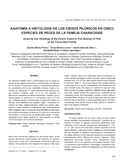Mostrar el registro sencillo del ítem
Anatomía e histología de los ciegos pilóricos en cinco especies de peces de la familia characidae
| dc.rights.license | http://creativecommons.org/licenses/by-nc-sa/3.0/ve/ | |
| dc.contributor.author | Medina Perozo, Zulamita | |
| dc.contributor.author | Martínez Leones, Teresa | |
| dc.contributor.author | Machado Allison, Antonio | |
| dc.contributor.author | Bonilla Rivero, Ana | |
| dc.contributor.author | López Rojas, Héctor | |
| dc.date.accessioned | 2009-11-09T19:11:37Z | |
| dc.date.available | 2009-11-09T19:11:37Z | |
| dc.date.issued | 2009-11-09T19:11:37Z | |
| dc.identifier.uri | http://www.saber.ula.ve/handle/123456789/29720 | |
| dc.description.abstract | Se realizaron análisis macro y microscópicos de los ciegos pilóricos en las especies Mylossoma acanthogaster, M. duriventre, M. aureum, Pygocentrus cariba y Cynopotamus venezuelae, procedentes de los ríos Catatumbo, Orinoco, Apure y Cunaviche en Venezuela. P. cariba presentó mayor número ciegos pilóricos oscilando entre 14 a 34. Las especies de Mylossoma mostraron un número intermedio, mientras que el menor número se observó en C. venezuelae, con 9 a 11 ciegos. Partiendo desde el lumen hacia la capa más externa, la mucosa está constituida por pliegues largos y profundos revestidos de tejido epitelial cilíndrico simple con células caliciformes y chapa estriada; la submucosa está conformada por tejido conjuntivo laxo; la muscular está dispuesta en tres estratos de fibras musculares, excepto en M. aureum, la cual posee dos estratos y la serosa por un epitelio plano simple. La histomorfología de los ciegos pilóricos de estas especies es similar a la de la mayoría de los peces teleósteos. | es_VE |
| dc.language.iso | es | es_VE |
| dc.rights | info:eu-repo/semantics/openAccess | |
| dc.subject | Ciegos pilóricos | es_VE |
| dc.subject | Histología | es_VE |
| dc.subject | Teleósteos | es_VE |
| dc.subject | Characidae | es_VE |
| dc.title | Anatomía e histología de los ciegos pilóricos en cinco especies de peces de la familia characidae | es_VE |
| dc.title.alternative | Anatomy and histology of the pyloric caeca in five species of fish of the characidae family | es_VE |
| dc.type | info:eu-repo/semantics/article | |
| dc.description.abstract1 | Macro and microscopy analyzes on the pyloric caeca of the species Mylossoma acanthogaster, M. duriventre, M. aureum, Pygocentrus cariba and Cynopotamus venezuelae were performed. The specimens were captured in locations of the Catatumbo, Orinoco, Apure and Cunaviche rivers in Venezuela. P. cariba showed the bigger number of pyloric caeca varying with number from 14 to 34; the other studied species had a number in between, while C. venezuelae showed the smaller number varying from 9 to 11 caeca. Histologically from the lumen to the most external layer, the mucosa is formed by long and deep folds covered by single cylindrical epithelial tissue with caliciform cells, striated sheets; the submucosa is conformed by lax conjunctive tissue; the musculature consists of three strata of muscular fibers, except in M. aureum which has only two strata and the serous formed by a simple epithelial plane. The histomorphology of the pyloric caeca of these species is similar to that of the majority of teleosts. | es_VE |
| dc.description.colacion | 607-618 | es_VE |
| dc.description.email | zulamitamedina@hotmail.com | es_VE |
| dc.description.email | teramartinleones@yahoo.com | es_VE |
| dc.description.email | amachado@ciens.ucv.ve | es_VE |
| dc.description.email | abonilla @ciens.ucv.ve | es_VE |
| dc.description.email | helopez@ciens.ucv.ve | es_VE |
| dc.description.frecuencia | Bimestral | es_VE |
| dc.identifier.depositolegal | 199102ZU46 | es_VE |
| dc.subject.institucion | Universidad del Zulia (LUZ) | es_VE |
| dc.subject.institucion | Universidad de Los Andes (ULA) | es_VE |
| dc.subject.keywords | Pyloric caeca | es_VE |
| dc.subject.keywords | Histology | es_VE |
| dc.subject.keywords | Teleosts | es_VE |
| dc.subject.keywords | Characidae | es_VE |
| dc.subject.publicacionelectronica | Revista Científica | es_VE |
| dc.subject.seccion | Revista Científica: Medicina Veterianaria | es_VE |
| dc.subject.thematiccategory | Medio Ambiente | es_VE |
| dc.subject.tipo | Revistas | es_VE |
| dc.type.media | Texto | es_VE |
Ficheros en el ítem
Este ítem aparece en la(s) siguiente(s) colección(ones)
-
Revista Científica - 2009 - Vol. XIX - No. 006
Noviembre - Diciembre 2009



